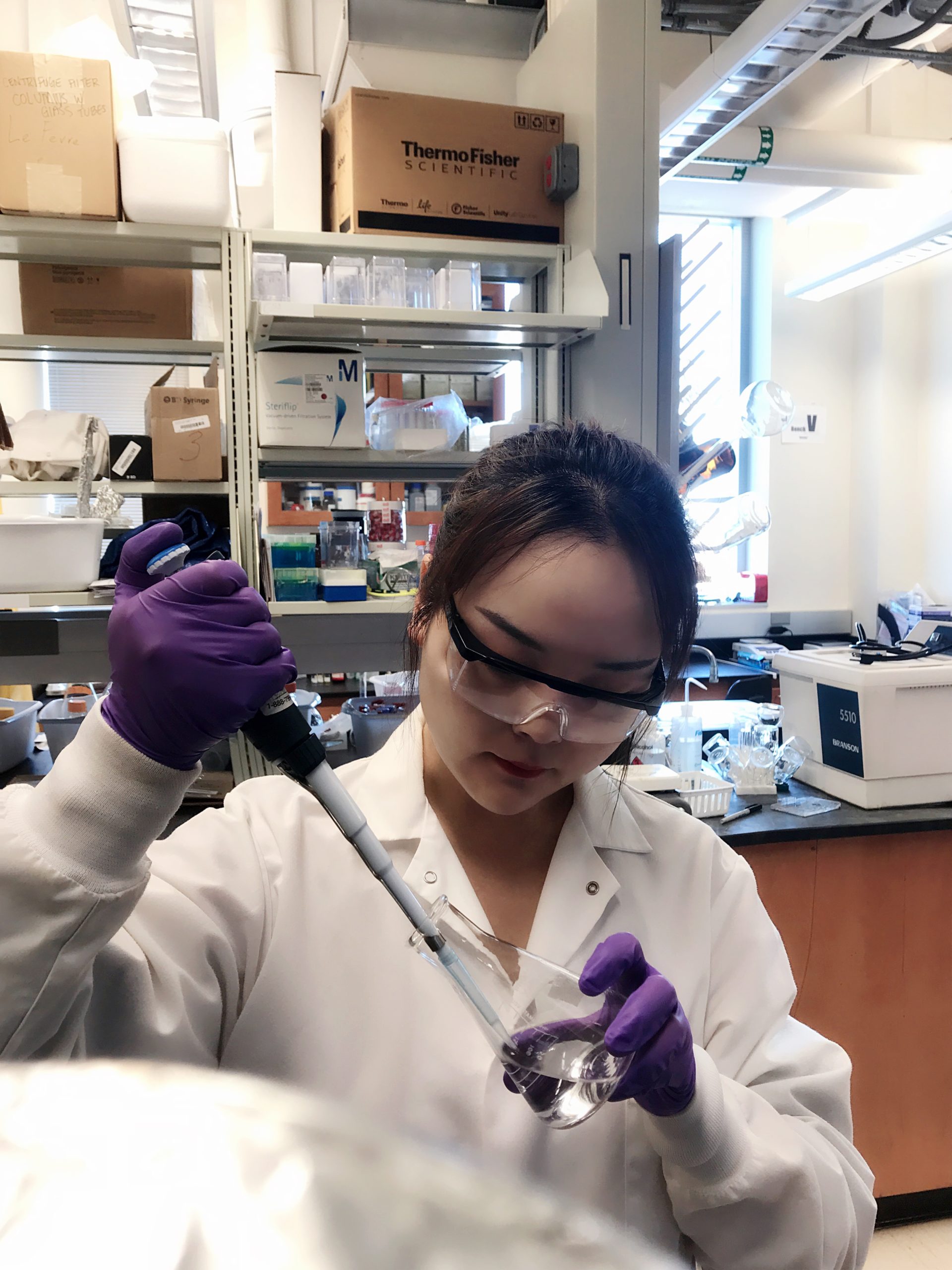We ask Keith Schilling, State Geologist and Research Scientist at the Iowa Geological Survey, the question: Why is groundwater important?
Continue readingAsk a Scientist – Fresh Water Mussels
We ask Craig Just, Associate Professor in Civil and Environmental Engineering at the University of Iowa, the question: How does the study of fresh water mussels affect Iowans?
Continue readingAsk a Scientist – Iowa Geological Survey
We ask Keith Schilling, State Geologist and Research Scientist at the Iowa Geological Survey, the question: What is the Iowa Geological Survey?
Continue readingAsk a Scientist – Communities and Flooding
Ask a Scientist – Resiliency Action Plans
We ask Craig Just, Associate Professor in Civil and Environmental Engineering at the University of Iowa, the question: What is a flood resiliency action plan?
Continue readingResearchers Looking into the Effects of Pharmaceuticals on Fish in Iowa’s Waterways
Written by Sarah Feehan
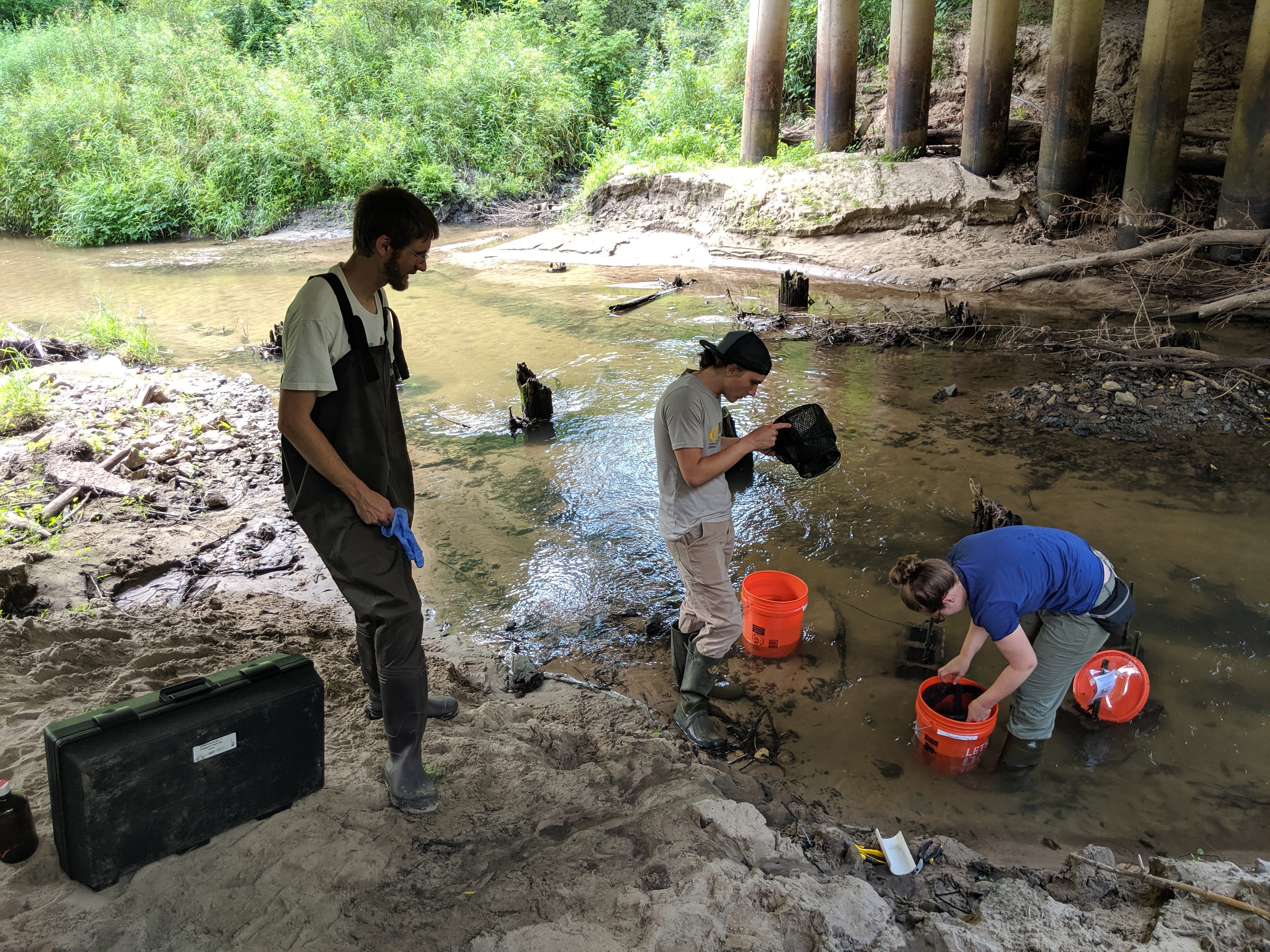
Lab-reared, native minnows have been living in fish cages placed in a stream for the last four days, and now a team of researchers collects them to study the impacts of water quality on aquatic organisms.
For nearly the past two years, these researchers have been measuring chemical concentrations in the same stream, and this caged fish experiment is one of the ways researchers are connecting chemical presence in the environment to possible biological effects.
Greg LeFevre, an assistant professor of environmental engineering and faculty research engineer for IIHR at the University of Iowa, studies water quality, wastewater, and toxic substances.
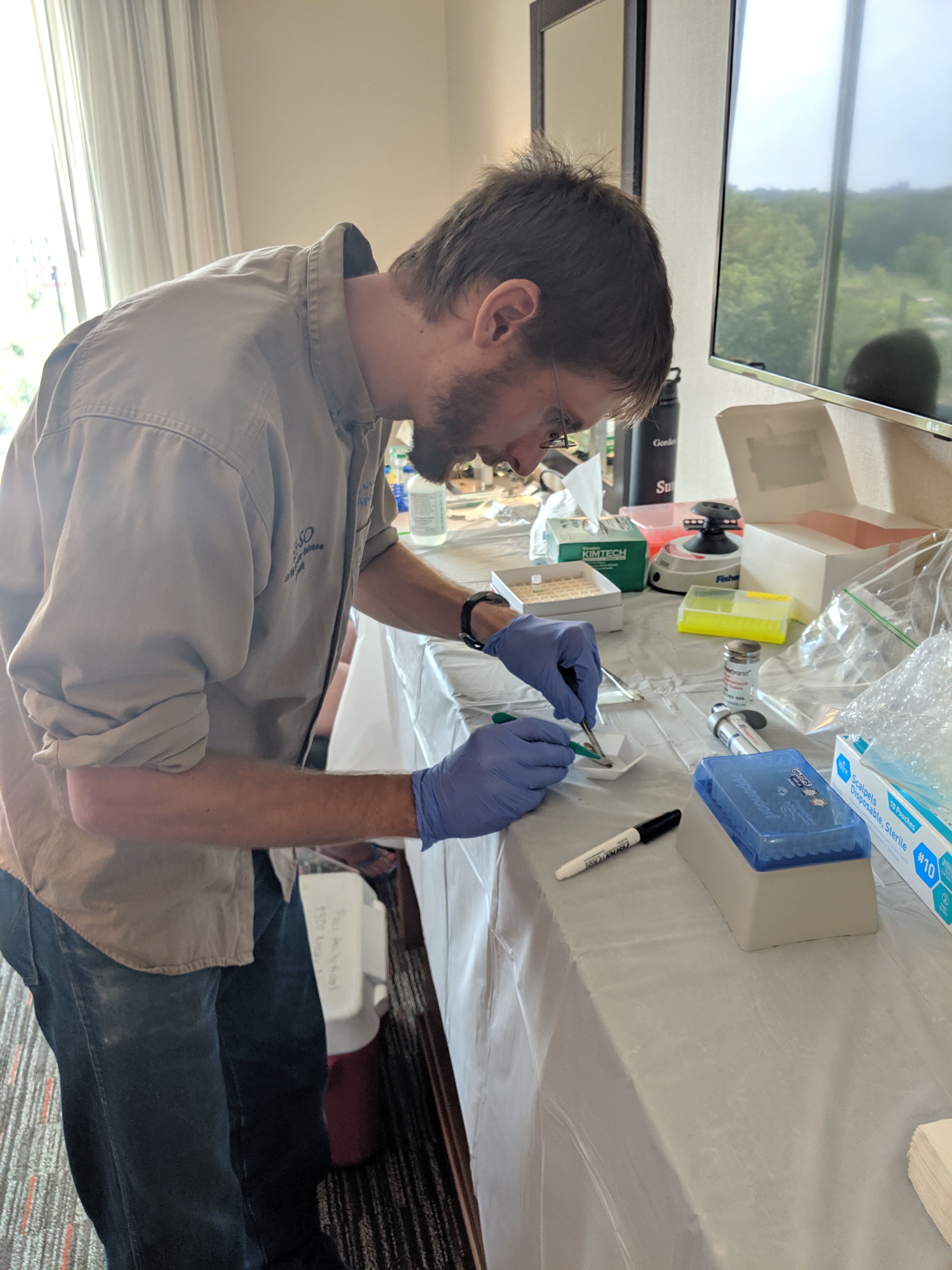
LeFevre, a principal investigator (PI) of the study, is researching what happens when pharmaceuticals enter our waterways. His research is funded through a National Competitive Grant under the USGS 104(g) Program. A goal of this program is to promote collaboration between the USGS and university scientists in research on significant national and regional water resources issues.
This working group consisted of representatives from the University of Iowa, the University of Wisconsin at Milwaukee, and the United States Geological Survey (USGS). There were PIs, graduate students, and USGS scientists.
“We have a number of different things we are working on both in the lab and in the field to try and answer the questions comprehensively through multiple fields of expertise,” LeFevre says. “And out of this one grant, because there are so many things coming out of this, we hope that this field site will be the locus for a bunch of other research.”
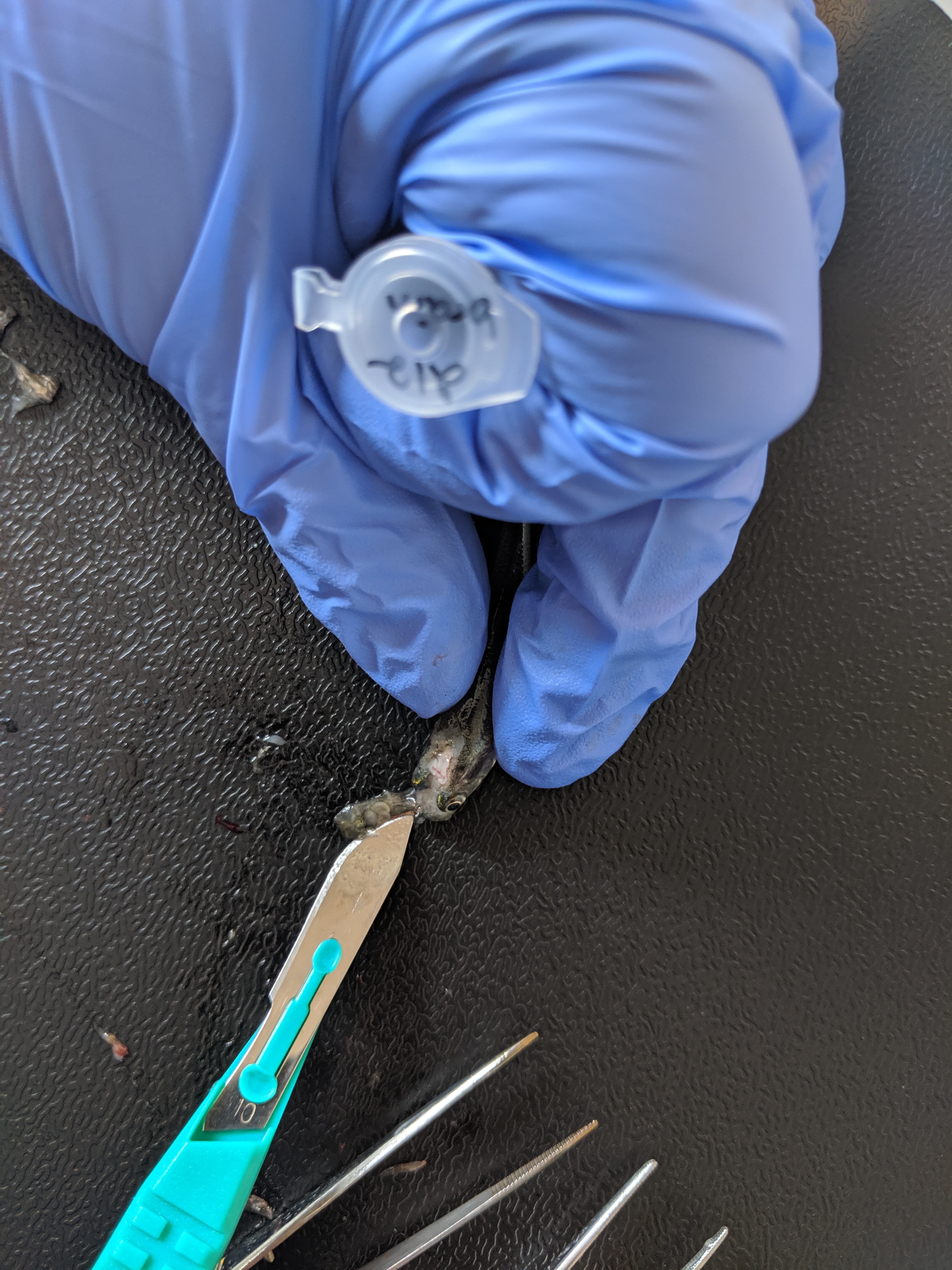
Wastewater-derived contaminants of emerging concerns (CEC) have demonstrated harmful effects to aquatic organisms. LeFevre believes that there is a critical need to understand how the changing complex mixture composition of CECs relates to biological effects. This understanding is critical in order to better protect ecosystem health in freshwater resources and inform stakeholder decisions.
“Everything that happens on the land is ultimately very connected to what goes on and into the water,” says LeFevre. “What we want to do is to develop some kind of understanding of the exposure to fish as well as some of the biological facts that are going on there.”
They hope to see the effects on fish throughout different areas of the stream. They will study a control group that permanently remains at the lab, a different group released in cages in the waterway after being brought up in the lab, and native fish who have spent their whole lives in the natural stream.
The waterway they are putting fish in and pulling fish from comes from an upstream wastewater treatment facility LeFevre describes as, “one of the best in the state.”
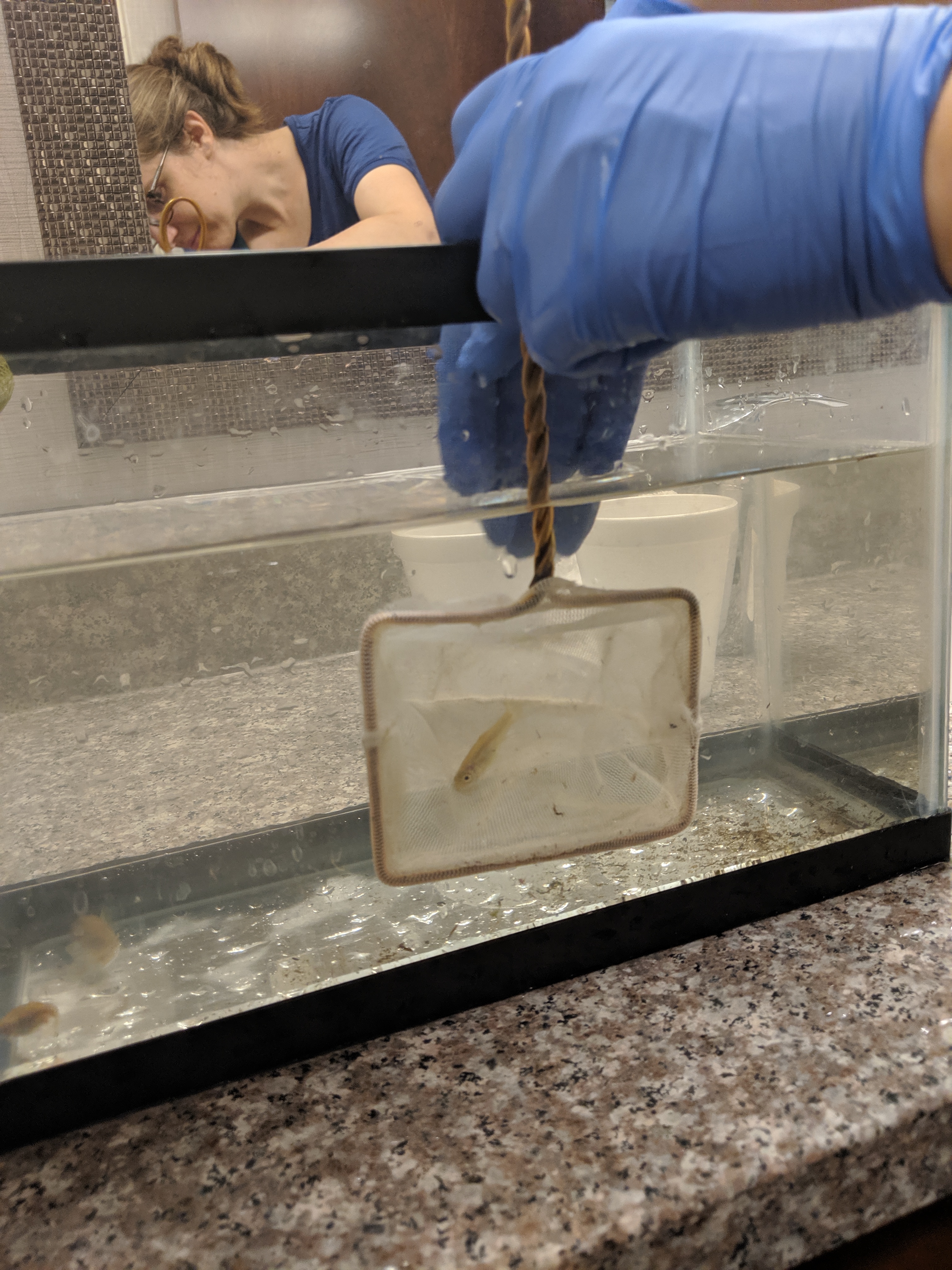
The North Liberty Wastewater Treatment Plant, upstream of the tested waterway, has a membrane bioreactor, zero E. coli that comes out of the plant, and biological phosphorus and nitrogen removal. All of which is far beyond the permit requirements.
Rebecca Klaper, professor at the School of Freshwater Sciences at the University of Wisconsin at Milwaukee, is a co-principal investigator on the study has also been a key collaborator to LeFevre’s research.
Regarding the data, Klaper explains, “The detection part is fantastic and the fact that we’ve gotten so much better at measuring these things is great. We might detect hundreds of chemicals in the water, but they might have no effect at all. So, the other part is trying to figure out if we really need to be concerned about them.”
“Today has been really exciting,” PhD candidate and research assistant at the University of Iowa Hui Zhi says. Zhi is one of four Iowa Water Center (IWC) Graduate Student Research Competition recipients for 2019.
“I think we were overprepared, which is great,” she says. “Having everything ready to go makes our work more efficient. And we also have so many people from our labs working together, making everything work very smoothly.”
Part of Zhi’s research through the IWC grant encompasses the sorption and biodegradation of pharmaceuticals in Iowa’s water. “It’s important we understand what’s in our drinking water, what’s in the treated wastewater, and what’s in the streams and rivers,” Zhi says.

Sarah Feehan is the communications specialist for the Iowa Water Center. She holds a BS in Journalism and Mass Communication with a minor in Political Science from Iowa State University. In fall of 2019, Feehan will begin acquiring her JD from Drake Law School.
Zhi Selected as a Recipient for the Iowa Water Center’s Institute Research Grant Competition
Written by Sarah Feehan, Communications Specialist
AMES, IOWA – The Iowa Water Center (IWC) annually administers a statewide grant competition known as the IWC Graduate Student Research Competition.
The purpose of this funding is to enable graduate students to complete additional research objectives beyond the scope of their current work, with an emphasis on submitting their research to peer-reviewed publications.
Hui Zhi has been selected among three other graduate students from across Iowa. She and the other recipients will receive funding for a variety of proposed research.

Zhi’s proposed research encompasses sorption and biodegradation of pharmaceuticals in Iowa’s water. It is titled ‘Quantifying Differential Sorption and Biodegradation of Pharmaceuticals in a Wastewater Effluent-dominated Stream in Iowa’.
Associate Director of the IWC Melissa Miller says, “Water Resources Research Institutes like the Iowa Water Center were authorized by Congress in part to address emerging water resources concerns through research. The fate and transport of pharmaceuticals in our water is of critical interest to both the state and region, and we look forward to sharing the results of Ms. Zhi’s work.”
“From this research, we’ll better understand the fate and transformation of pharmaceuticals in the surface water. It’s important we understand what’s in our drinking water, what’s in the treated wastewater, and what’s in the streams and rivers. And, how they change spatially and temporally,” Zhi says.
Get to Know Hui Zhi, PhD Candidate at the University of Iowa
Typically, Zhi wakes up around 6:30 A.M. and makes herself breakfast and a cup of black coffee. Once at her office, she checks emails and reads journal article updates.
One early morning in her office, Zhi received an email about the IWC’s grant competition and thought, “it would be a really great opportunity to apply for.” She spoke to her adviser about the competition and he encouraged her to write and submit a proposal.
“It caught my eye,” Zhi says of the grant competition email. Zhi’s research from this grant work will be a one-year study that employs both field and laboratory research approaches.
Zhi says, “I really enjoy working in the lab and look forward to getting the results.”
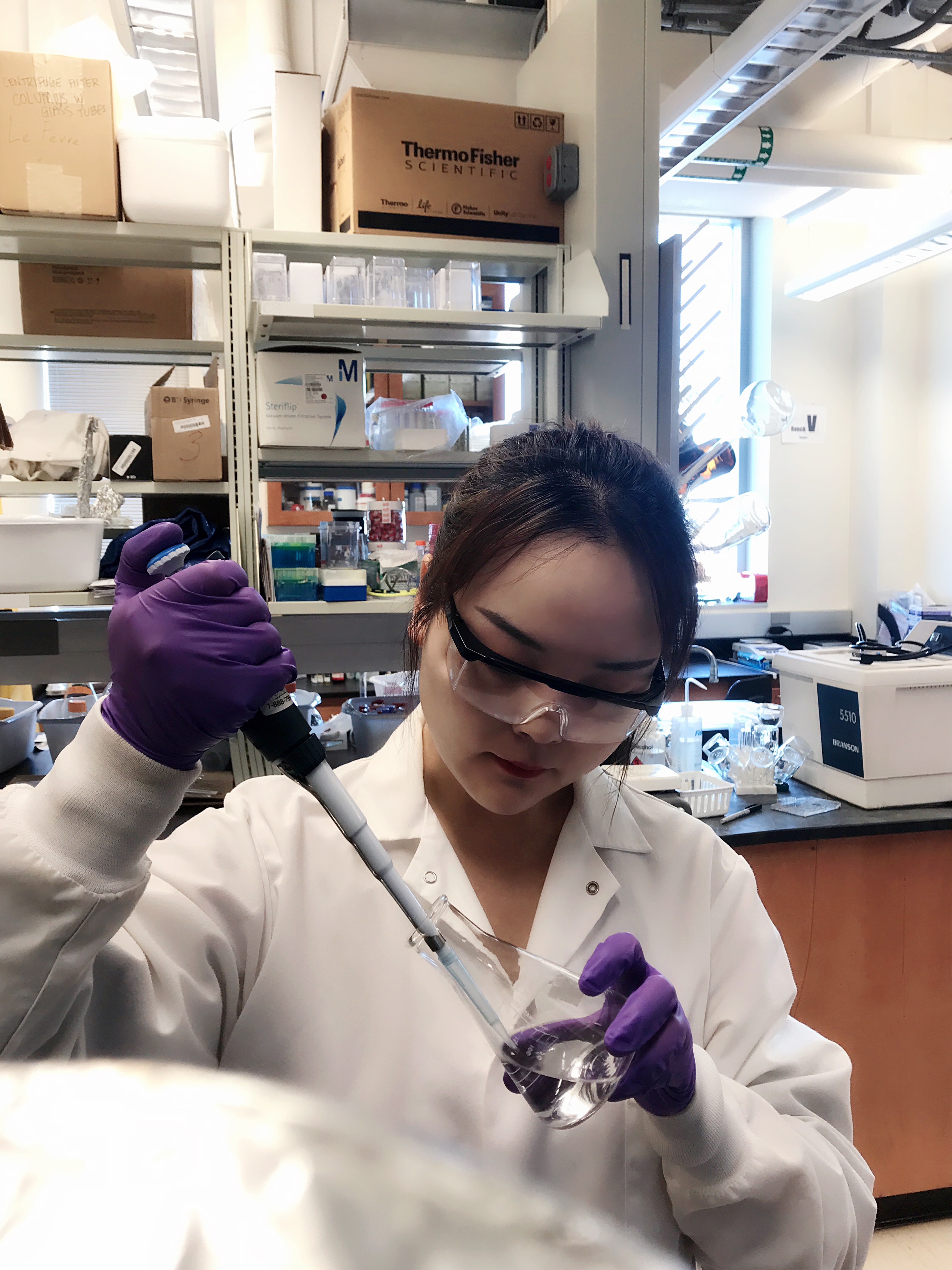
Zhi grew up in China, where she completed her bachelor’s degree in an environmental science program at China Pharmaceutical University.
The environmental crisis in China influenced Zhi to continue school and to focus on environmental engineering. She decided to continue her studies here in the United States, where Zhi believes, “the best programs in the world for environmental engineering are at.”
She received her master’s degree at Cornell University and is now a PhD candidate at the University of Iowa. Her anticipated completion year is 2020.
With her research, Zhi hopes people will better understand the behaviors of pharmaceutical mixtures in the water and their associated ecological impacts.
She explains, “The results will be able to help the right people, whoever is responsible for our water policy regulations, set in place science-based water quality regulations for pharmaceuticals. Regulations not just for our drinking water, but also in the treated wastewater that is discharged into our environment. Hopefully then, we will have a cleaner water environment.”
Instead of just focusing solely on the quality of our drinking water, Zhi thinks knowing what’s going on in all our water systems, for example streams and rivers, is vital to a healthy environment.
Pharmaceuticals can have impacts on aquatic species, such as fish, living in the water. If pharmaceuticals are accumulating in fish and people are eating these fish, the accumulation of pharmaceuticals ends up in human bodies.
Therefore, not only are we drinking pharmaceuticals, but we are also eating fish that have been accumulating pharmaceuticals over time. “People need to know what’s happening in the streams nearby that they’re swimming in and also in the waters their fish are found because there are potential impacts on the human body that we don’t clearly know yet,” Zhi says.
To help prevent research burnout, Zhi enjoys exercising. “Whether it’s cardio, yoga, boxing, rock climbing, or swimming, I love it. All these different sports help relieve any pressure from research, and I have a lot of fun doing them,” Zhi says.
For more information about this year’s recipients, please visit https://iawatercenter.wordpress.com/. To reference the general press release for all four recipients, please visit: http://www.water.iastate.edu/news/iowa-water-center-announces-2019-grant-recipients.
The Iowa Water Center is a federally funded organization, part of the National Institutes for Water Resources. Located on the Iowa State University campus, it is one of 54 institutes located throughout the United States and U.S territories. The purpose of the Iowa Water Center is to identify water-related research needs, provide outreach and education opportunities, and disseminate information about Iowa’s water resources to the public to form better policies and everyday practices. Learn more at https://www.water.iastate.edu/.
 Sarah Feehan is the communications specialist for the Iowa Water Center. She holds a BS in Journalism and Mass Communication with a minor in Political Science from Iowa State University. In fall of 2019, Feehan will begin acquiring her JD from Drake Law School.
Sarah Feehan is the communications specialist for the Iowa Water Center. She holds a BS in Journalism and Mass Communication with a minor in Political Science from Iowa State University. In fall of 2019, Feehan will begin acquiring her JD from Drake Law School.
The Realms of Flood Resilience: protecting our communities
Post submitted by Craig Just, assistant professor for the Department of Civil and Environmental Engineering at the University of Iowa and Ashlee Johannes, coordinator for the Iowa Watershed Approach Flood Resilience Program.
How can we become more flood resilient?
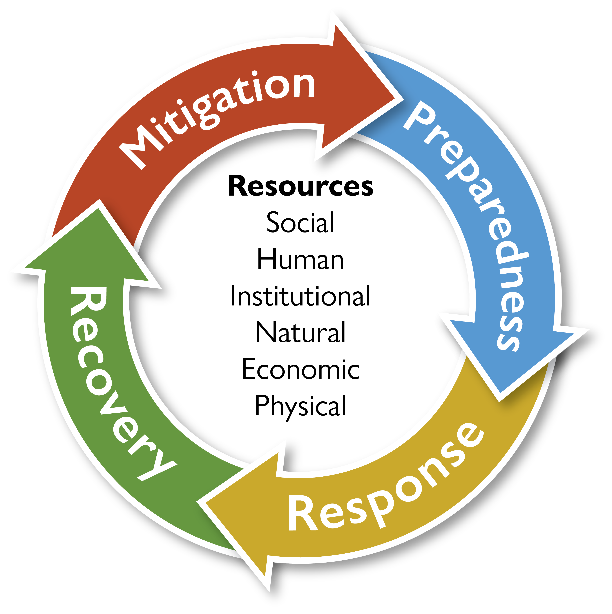 Community resilience is a recent desire for communities that face a serious disruption in their routine. But, what is resilience? A resilient community is able to mitigate, prepare for, respond to, and recover from an adverse event, including floods. The Iowa Watershed Approach (IWA) Flood Resilience Team views resilience in terms of six “resources”—social, human, institutional, natural, economic, and physical. A community’s resilience depends on its capacities in each of these areas, as well as the engagement and unity of its citizens.
Community resilience is a recent desire for communities that face a serious disruption in their routine. But, what is resilience? A resilient community is able to mitigate, prepare for, respond to, and recover from an adverse event, including floods. The Iowa Watershed Approach (IWA) Flood Resilience Team views resilience in terms of six “resources”—social, human, institutional, natural, economic, and physical. A community’s resilience depends on its capacities in each of these areas, as well as the engagement and unity of its citizens.
During the first year of the IWA, the Flood Resilience Team trekked 10,000-miles, crisscrossing the state of Iowa and visiting diverse watershed communities to recognize their progress and understand their hurdles towards building a resilient community. In the process, our team observed a common resource that was missing in their actions: social resilience. Social resilience, at a community scale, is challenging to describe and quantify, so we have committed our focus to this topic. Our flood resilience programming has three goals that all strive towards improving social resources, and other resilience resources, for the IWA watersheds: 1) measure, visualize, and communicate flood resilience resources; 2) enhance flood resilience content in formal watershed plans; and 3) improve social resources of flood resilience.
A critical action for the Flood Resilience Team is the creation of interactive maps that display social vulnerability at the intersections of flood risk for each IWA watershed. With this information, watershed representatives can identify areas of high social vulnerability (or lower resilience). Furthermore, users will be able to pinpoint the underlying drivers of the vulnerable area (e.g., prominently low-income neighborhoods, people with disabilities, large children population) for targeted outreach and emergency response purposes. We will also empower community planners to use this information to implement flood mitigation strategies that protect socially vulnerable populations.
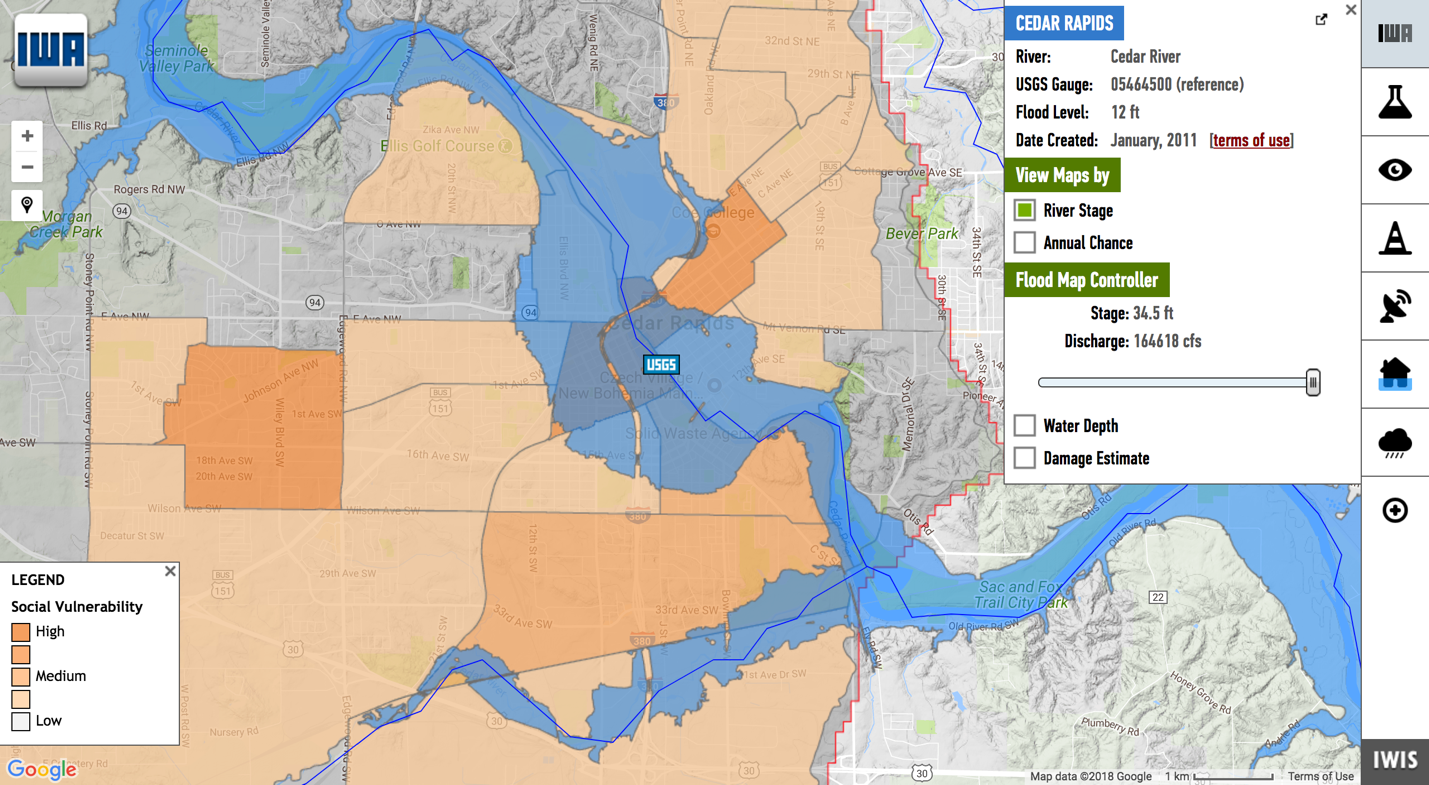
With assistance from IWA partners, the Flood Resilience Team is contributing to flood mitigation planning by connecting hazard mitigation and watershed plans to expand opportunities for other funding sources. To facilitate this process, damage and loss estimates to structures and their contents will be available online. This information, in addition to the social vulnerability maps, will be useful for emergency response, outreach, and planning purposes. To view the most recent version of these digital maps, visit: http://iwa.iowawis.org/.
Learn more about the IWA Flood Resilience Program at the Annual Iowa Water Conference on March 21-22 at the Scheman Building at Iowa State University in Ames. Lead presenter Ashlee Johannes will host a breakout session about the evolution of the flood resilience program and building a more resilient state.
Together, we can make our watershed communities more flood resilient. For more information about the IWA Flood Resilience Program, visit: http://www.iowawatershedapproach.org/programs/resilience/.
About the Authors:
Craig Just, PhD, is assistant professor for the Department of Civil and Environmental Engineering at the University of Iowa (UI). He is also an affiliate of the UI’s Water Sustainability Initiative. As the team leader of the Iowa Watershed Approach Flood Resilience Program, he develops and manages resilience programming actions and products.
Ashlee Johannes, MS, is the coordinator for the Iowa Watershed Approach Flood Resilience Program. She assists with product development, facilitates communication of the resilience programming activities, and fosters engagement with IWA watershed groups, partnering organizations, and other stakeholders.
Notes from a newly forming WMA: Developing a replicable program with the Iowa Watershed Approach
In September, Iowa Water Center staff were spread across the state to attend the fall meetings of several Watershed Management Authorities (WMAs). One of these meetings was the North Raccoon Watershed Management Coalition (NRWMC), held on September 20th in Lake City, Iowa (whose town welcome sign proudly proclaims they have “everything but a lake!”).
The nine different watersheds in the Iowa Watershed Approach started at varying stages of WMA development. North Raccoon was one of those in the beginning stages that did not have a WMA prior to the Iowa Watershed Approach start date. The 28E agreement was filed in the spring of 2017, and this was the second quarterly meeting since that time. Because the group is so new, the topics touched on at this meeting may be helpful to other newly forming WMAs, whether they are part of the Iowa Watershed Approach project or not.
Managing a large group
One of the challenges for NRWMC is that the sheer size of the watershed leads to many potential entities (cities, counties, and Soil and Water Conservation Districts) for the 28E agreement. NRWMC did an excellent job securing participation of 36 entities, but with each entity receiving a board seat (as is common practice with WMAs), it can be difficult to find a meeting time with enough board members to secure a quorum. To address this issue, board members can participate by phone, or designate proxies.
One of the first actions the NRWMC needs to take is hiring a watershed coordinator. A watershed coordinator is a jack-of-all-trades that coordinates the WMA board as well as WMA-related activities in the watershed. NRWMC designated a subcommittee for hiring at a previous meeting, but the entire coalition will need to approve the hiring of the individual recommended by the subcommittee. With only meeting quarterly and the necessity of a high number of members required for a quorum, NRWMC chose to schedule a telephonic board meeting once the subcommittee had prepared their recommendation.
Board education
Like other WMAs, NRWMC board members are not necessarily experts in watershed management. Board chair Mark Hanson took some time at this meeting to give an overview of the history of the watershed. As a new group, it is beneficial for the board to pause and reflect on what has shaped the watershed in the past – both recent land use and weather events as well as the historical geology of the region.
This information segued nicely into a presentation by Tony Loeser, Water Resources Engineer at IIHR Hydroscience and Engineering at the University of Iowa, as he explained what NRWMC could expect from the expansive hydrologic assessment being conducted by his group. Included in the hydrologic assessment:
- climate and historical streamflow assessments (including average rainfall, streamflow patterns, floods of record, and abnormal weather patterns)
- data sets that describe watershed characteristics (geology and soils, land use, BMP mapping, topography, unique characteristics that contribute to the way water moves in the watershed)
- instruments/data record (streamflow and rainfall)
- watershed scaled hydrologic model runs that are compared with observed responses to rainfall events
Tony’s presentation did a great job of outlining the how, the why, and the “so what?” of the hydrologic assessment. Even though NRWMC won’t have those results for several months (all that data gathering and analysis takes time!), understanding what’s to come helps this new group in their understanding of the watershed management process.
One final observation: the power of complete and concise meeting minutes cannot be overstated (especially with a 36-member board). Hats off to the board secretary for judicious recording of meeting happenings (including documentation of University of Iowa Center for Evaluation and Assessment Julie Kearney’s predictive score for the Iowa-Penn State game!).
This is part three in a series on the Iowa Watershed Approach. Read our other coverage below:
Working with your Watershed Partners – Part 1
Getting to know your Watershed Pt. 2

